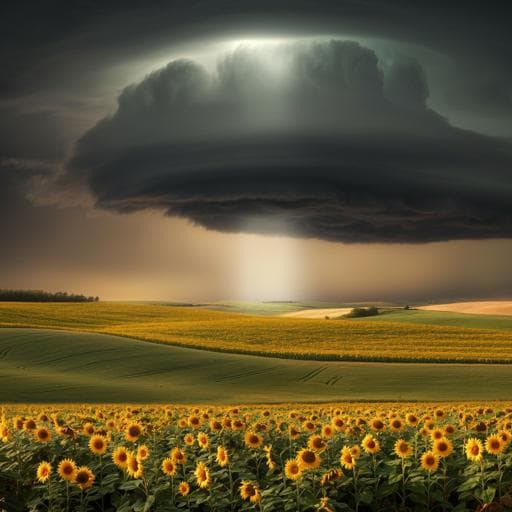
Agriculture
Quantification of losses in agriculture production in eastern Ukraine due to the Russia-Ukraine war
B. Chen, Y. Tu, et al.
This study by Bin Chen, Ying Tu, Jiafu An, Shengbiao Wu, Chen Lin, and Peng Gong reveals the devastating impact of the Russia-Ukraine war on Ukrainian agriculture using innovative satellite imagery and machine learning techniques. The assessment found that about 18.11% of croplands were left unplanted, leading to significant losses in crop production, particularly in wheat and sunflower.
~3 min • Beginner • English
Introduction
Since February 2022, the Russia–Ukraine war has disrupted Ukrainian agriculture with ramifications for global food security, especially in middle- and low-income countries dependent on Ukrainian exports. Interruptions to production and energy infrastructure have amplified food insecurity and price volatility amid overlapping crises (pandemic, climate shocks) and trade restrictions. While multiple short-term responses have been proposed (e.g., expanding cropland, humanitarian aid, easing export restrictions, flour blending), these entail trade-offs (e.g., carbon costs, affordability of dietary shifts). Quantitative, spatially resolved assessments of war-induced agricultural production losses are essential to weigh costs and benefits of policy options, guide emergency relief, and target assistance. Previous assessments are often descriptive or scenario-based and lack spatial-temporal granularity or focus on single crops. This study aims to provide a comprehensive, high-resolution evaluation of losses by: (1) mapping major crops across Ukraine cost-effectively; (2) quantifying production reductions and associated economic losses since the war; and (3) relating production losses to war intensity. The focus is on wheat, maize, sunflower, and rapeseed—about 90% of 2021 production—with detailed loss assessments in five high-risk eastern provinces.
Literature Review
Prior work on the war’s agricultural impacts includes descriptive analyses and scenario modeling that assume specific export reductions, which are static and miss spatial-temporal heterogeneity. Remote sensing has been used to delineate croplands and monitor wartime agriculture, including studies in Ukraine, but many focus on single crops (often wheat) or lack clear crop-type distinctions. Although decreases in 2022 production have been documented, the attribution to war intensity has been unclear. Nighttime lights (NTL) have been shown as reliable proxies for conflict-related socioeconomic damage in other contexts and provide a potential link to agricultural disruption. This study addresses gaps by producing a detailed, multi-crop map, assessing both direct (unplanted) and indirect (yield reduction) losses, and explicitly relating losses to war intensity via NTL within a rigorous regression framework.
Methodology
- Study scope and crop mapping: Mapped four major crops (wheat, maize, sunflower, rapeseed) at 10 m resolution across Ukraine, then focused loss assessment on five eastern provinces (Crimea, Donets'k, Kherson, Luhans'k, Zaporizhzhya) where wheat, sunflower, and rapeseed dominate (76.8% of cropland).
- Data sources: Sentinel-2 L2A surface reflectance (2019–2022) with Blue, Green, Red, NIR, SWIR1, SWIR2 bands and indices NDVI, NDYI; monthly mean composites March–November. Sentinel-1 SAR GRD (VV, VH, VV/VH), processed via ARD (noise correction, speckle filtering, terrain normalization), monthly means March–November at 10 m. VIIRS monthly NTL (500 m) as war-intensity proxy. ESA WorldCover 10 m 2020 cropland mask. Global Urban Boundary (GUB) dataset for urban extent. ERA5-Land for precipitation and GDD. Administrative boundaries from GADM.
- Validation samples: Two independent sets. (1) 954 points countrywide for crop type validation (~200 per class: wheat, sunflower, rapeseed, maize, other), curated using literature, time-series signals, high-res imagery, and Street View. (2) 473 points in five eastern provinces for planting condition (planted vs unplanted) in 2022, determined via a GEE tool comparing multi-year NDVI time series.
- Semi-supervised crop classification: Within WorldCover cropland, extracted monthly Sentinel-1/2 time series (2019–2021). Applied K-means clustering; labeled clusters by similarity to validation samples; generated training parcels. Partitioned country into four subregions to account for geographic and phenological variability; repeated sampling within each; merged samples to train a universal Random Forest classifier to produce the 2020 10 m crop map. Accuracy assessed via confusion matrix (overall accuracy 89.83%, Kappa 0.87).
- Planting condition identification (2022): Used monthly Sentinel-2 NDVI to detect planting/growth. Based on phenology, separated crops into wheat (NDVI peak Mar–May) and sunflower/rapeseed (peak Jun–Aug). Thresholds: wheat planted if peak NDVI Mar–May 2022 > 0.25; sunflower/rapeseed planted if peak NDVI Jun–Aug 2022 > 0.32; otherwise unplanted. Validation yielded OA 90.68% and Kappa 0.79.
- Sample-based area estimation: Followed recommended good practices for area estimation from map-classified strata using stratified estimators, computing standard errors and 95% CIs from confusion matrices.
- Production change metrics: For planted areas, computed NDVI difference and loss rate: NDVIdifference = mean NDVI (2019–2021) – mean NDVI (2022) during crop-specific growing seasons; NDVIloss = NDVIdifference / mean NDVI (2019–2021). Positive NDVIloss indicates reduced production potential.
- Economic loss estimation: Direct loss Ldirect,k = Aunplanted,k × Outputk. Indirect loss Lindirect,k = Aplanted,k × Outputk × NDVIloss,k. Outputk based on U.S. FAS yield and prices (2020–2021): wheat 152 MT/km² at $268/MT; sunflower 34 MT/km² at $1293/MT; rapeseed 57 MT/km² at $630/MT. Reported primarily using sample-based areas and 95% CIs.
- War intensity vs production loss: Computed NDVI differences around 130 urban areas (GUB polygons >10 km²) using concentric buffers (1–20 km) and 8 directional sectors for 10 km buffers. Related urban NTL loss to surrounding cropland NDVI difference.
- Regression analyses: Constructed 0.1° × 0.1° grids (cropland area >10 km²) across the five provinces, calculated annual grid means (NDVI, precipitation, GDD, NTL) for 2019–2022. Model I (fixed effects): NDVI_it = β1 Precip_it + β2 GDD_it + β3 NTL_it + μ_i + δ_t + ε_it; δ_2022 captures war-year effect. Model II (differences): dNDVI_i = β1 dPrecip_i + β2 dGDD_i + β3 dNTL_i + β4 NPA_i + ε_i, where NPA is unplanted area in 2022. Reported coefficients, standard errors, significance, R², and observations.
Key Findings
- National crop mapping (2020): Overall accuracy 89.83%, Kappa 0.87. Area shares: maize 31%, wheat 28%, sunflower 22%, rapeseed 7%, other 12%. Southeastern Ukraine dominated by wheat, sunflower, rapeseed; northwestern dominated by maize.
- Unplanted area (2022, five eastern provinces; sample-based): 18.11 ± 2.47% of cropland unplanted, totaling 16,956 ± 2,308 km² across wheat, sunflower, rapeseed. Crop-specific unplanted rates: wheat 22.05 ± 3.37%; sunflower 14.79 ± 4.91%; rapeseed 7.57 ± 6.06%. Provincial unplanted proportions (all three crops): Kherson 24.84 ± 6.48% (largest), Crimea 19.37 ± 8.68%, Luhans'k 17.24 ± 5.01%, Zaporizhzhya 16.89 ± 4.39%, Donets'k 13.58 ± 4.70%.
- Indirect production losses in planted areas (NDVI loss vs 2019–2021): Wheat 37.19%; Sunflower 36.68%; Rapeseed 36.39%. Largest provincial losses: wheat in Donets'k 44.66%; sunflower in Kherson 39.43%; rapeseed in Luhans'k 41.69%.
- Economic losses (million USD, sample-based, 95% CI): Indirect losses exceeded direct by 1.31–2.16×. Indirect: wheat $520.36 ± 22.52; sunflower $427.59 ± 24.62; rapeseed $205.02 ± 11.53. Direct: wheat $395.85 ± 60.55; sunflower $202.31 ± 67.11; rapeseed $94.70 ± 31.70.
- Proximity and directionality: NDVI losses near urban centers were larger, decreasing with buffer distance (1–20 km). Within 10-km buffers, largest NDVI differences occurred in southeast directions (45°–180°), aligning with directions of troop advances.
- War intensity linkage: Positive relation between urban NTL loss and surrounding cropland NDVI difference in 10-km buffers (R² = 0.18, p < 0.05). In regression Model II, one-unit reduction in NTL associated with 1.4% NDVI loss (β = 0.014, p < 0.1).
- Determinants of production: Fixed-effects Model I showed precipitation (β = 0.154, p < 0.01) and GDD (β = 0.002, p < 0.1) positively associated with NDVI; NTL had limited effect. Significant time effect δ_2022 = −0.115 (p < 0.01) indicates mean NDVI in 2022 was 11.5% lower than 2019–2021 average, consistent with war impacts.
Discussion
The study provides a rapid, spatially explicit framework to quantify war-induced agricultural disruptions by integrating multi-source remote sensing, semi-supervised crop mapping, and regression analysis. Results show substantial direct (unplanted) and indirect (yield-related) losses in eastern Ukraine during 2022, with indirect losses dominating. Losses were heterogenous across crops and provinces, with Kherson and other frontline regions exhibiting the largest unplanted shares and planted yield reductions. Proximity to urban centers and the southeastward direction consistent with troop movements were associated with larger production declines. Regression analyses underscore that while climatic factors generally enhance crop productivity, the 2022 time effect and NTL-based measures of conflict intensity correlate with significant production shortfalls, supporting the interpretation that war-related damages (infrastructure, labor, inputs) drove observed declines. The approach aids targeted humanitarian response, infrastructure restoration prioritization, and policy evaluation to stabilize regional and global food supply chains.
Conclusion
This work delivers a high-resolution, multi-crop classification for Ukraine and a comprehensive assessment of 2022 agricultural losses in five high-risk eastern provinces. Approximately one-fifth of cropland went unplanted and planted croplands suffered ~36–37% production losses, yielding indirect economic damages that surpassed direct ones. War intensity proxied by nighttime lights is significantly associated with production declines, providing an operational indicator for monitoring conflict impacts on agriculture. The methodology—combining Sentinel-1/2 data, semi-supervised learning, NDVI-based yield proxies, and econometric attribution—offers a transferable framework for conflict-related agricultural damage assessment beyond Ukraine. Future work should expand crop coverage beyond the four major types, incorporate alternative or complementary yield indicators and ground measurements, model downstream supply-chain and health impacts, and extend time-series tracking to quantify cumulative and recovery dynamics as the conflict evolves.
Limitations
- Crop coverage: The 10-m map focuses on four major crops (~90% of production); other crops were excluded due to limited high-quality samples.
- Baseline choice: Using 2019–2021 averages as the pre-war baseline may introduce bias from interannual crop conversions.
- Socioeconomic pathways: Loss estimates consider only unplanted areas and reduced production in planted areas; downstream effects on processing, logistics, markets, and health are not modeled.
- Yield proxy: Reliance on Sentinel-2 NDVI may underperform compared to other vegetation indices or in-situ measures for yield estimation, introducing uncertainty.
- Temporal scope: Assessment covers the first war year; ongoing conflict may have cumulative or evolving effects requiring longitudinal monitoring.
Related Publications
Explore these studies to deepen your understanding of the subject.







